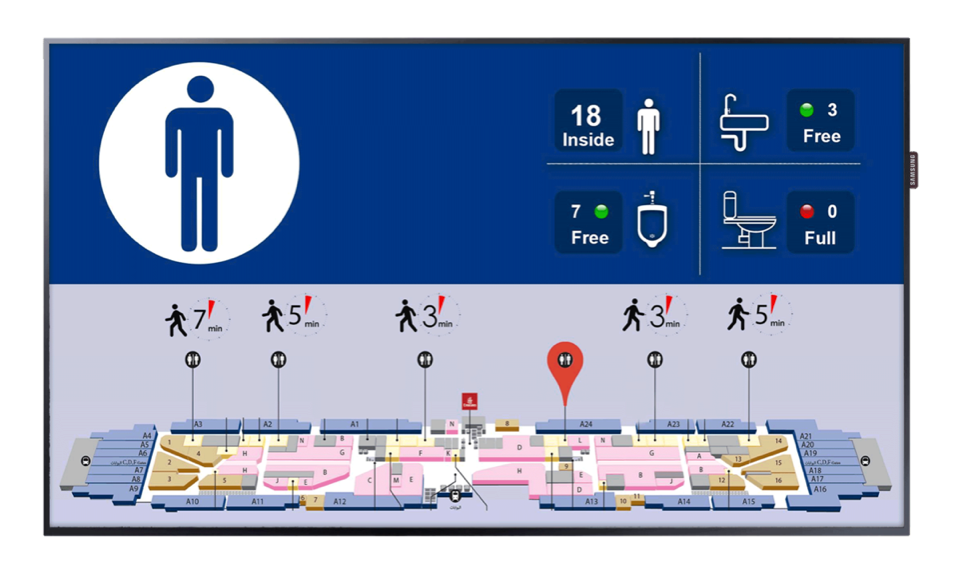
By David Levin
With Wi-Fi-enabled devices producing an endless stream of data, businesses have an opportunity to use that information to improve multiple aspects of the customer experience—even in the bathroom.
Dubai International Airport, the world’s third busiest airport, is installing signage at restroom entrances around their concourses, designed to improve the passenger experience. Why? Because the cleanliness and availability of restrooms impacts how passengers rank airport satisfaction.
That’s why Singapore’s Changi Airport has urinals with views of the runway and why Thailand’s Koh Samui Airport features bathroom fish tanks.
Dubai’s new screens visually tell passengers—regardless of their language—the vital information they need. At a glance, passengers can tell how many stalls are occupied and how many are free, see the location of other facilities, and how long it would take to walk there. That information is provided by bathroom fixtures armed with sensors that can tell when a stall or a urinal is in use. Feeding that data through software to a user-friendly visual display creates actionable information that improves the passenger experience.
Dubai is not alone in using bathroom data to better serve customers. In Houston, bathrooms in George Bush Intercontinental Airport and William P. Hobby Airport are using sensors to count passenger traffic and send cleaning alerts to janitorial staff.
Improving bathroom efficiency is just one way that Dubai is using technology in innovative ways at its airports. It’s experimenting with “virtual border” tunnels: Passengers will walk through a tunnel, displaying images of an aquarium, equipped with about 80 cameras that use artificial intelligence technology to scan faces. If it works as planned, the tunnel could eliminate the need for a more formal security clearance process, currently a major stress point for passengers.
The airport has set a goal of becoming the world’s busiest airport within five years, moving 90 million passengers. As part of that initiative, the airport is currently reviewing all signage, digital and traditional, in an attempt to improve passenger movement and satisfaction now and into the future.
The airport has more than 1,500 signs for wayfinding, including maps of the airport on 40-inch LCD touch screens, real-time data on flight departures and arrivals and directions to gates, restaurants and shops.
Dubai Airport is crunching more than 4.5 billion pieces of data points from computer system logs, sensors andair traffic control systems. If used correctly, that data can be used to drive efficiency improvements, from cutting energy use to faster baggage handling. Michael Ibbitson, head of technology and infrastructure at Dubai Airports, says technology is vital as the authority expands its airports. “Growth has to come through innovation and automation,” he told Computerworld UK. “We don’t want to be the biggest, we want to be the best, with new levels of customer service.”
The smart use of data in airports serves three purposes—giving passengers control, increasing their confidence and boosting their engagement. Increasingly, data is being used transparently throughout airports to serve these goals. For example, Southwest Airlines tested new screens at Dallas Love Field airport with the goal of taking some of the stress out of waiting for a flight. The screens show customers how full a flight is and suggestions for things to do before boarding, based on dynamic wait-time data.
And here’s where things get really interesting: The types of technology and data being leveraged to improve the passenger experience in Dubai’s and other airports around the world, are the same ones behind the integrated meeting room systems that make reserving and using office conference rooms easier. Those systems can also use sensors to track who enters a reserved room and to release the room after 15 minutes if no one arrives for a scheduled meeting. Displays can even be used to extend reservations or connect with support staff.
Pushing data to the people that need it—whether outside an airport bathroom in Dubai or a conference room in Denver—makes that information actionable and therefore more valuable.
The smartest companies will figure out the best ways to use their data in visual, actionable ways, no matter where that information originates, or what challenges they’re trying to solve.
David Levin is president and CEO of Four Winds Interactive.
